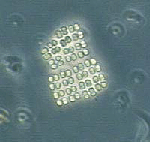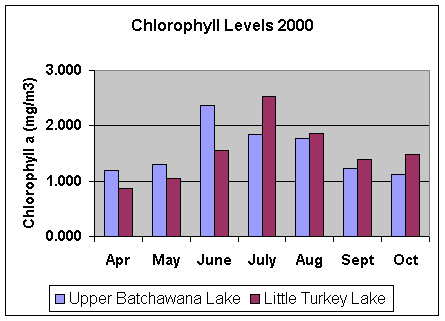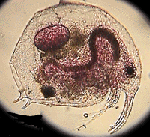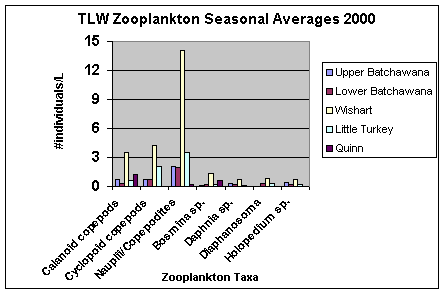Fish and other aquatic biota at Turkey Lakes watershed
Biological data have been collected with varying intensity in the TLW since 1980. No major anthropogenic perturbation has occurred on the lakes and they have been closed to fishing since that time. The biotic databases thus provide an opportunity to analyze long-term 'natural' variability in populations. The Fish Habitat Manipulation Experiment (treatment commenced in the fall of 1999) and associated biotic monitoring exclude Turkey Lake.

Brook Trout
(Salvenius Fontinalis)

Common White Sucker
(Catastomus commersoni)

Northern Redbelly Dace
(Chrosomus eos)
Fish
Prior to 1980, no fish were present in either basin of Batchawana Lake, the highest elevation headwater lake in the TLW. After an accidental introduction occurred in the early 1980s, Lower Batchawana Lake was experimentally stocked with 1000 brook trout (Salvelinus fontinalis) in 1985. Brook trout populations have since become established in Upper and Lower Batchawana Lakes. Northern redbelly dace has also established populations in both basins, the source of which is unknown.
Of the three downstream lakes, Wishart Lake contains fewer species (8) than either Little Turkey Lake (11) or Turkey Lake (9). Eight species are common to all three lakes, including: brook trout, white sucker (Catostomus commersoni), burbot (Lota lota), lake chub (Couesius plumbeus), northern redbelly dace (Chrosomus eos), and emerald shiner, (Notropis atherinoides).
The streams interconnecting the lakes and below the outlet of Turkey Lake support only a limited number of species, and brook trout exist only in the stream (Norberg Creek) below Turkey Lake. Two species, lake chub and northern redbelly dace, were ubiquitous however and the presence of stream species in all three lakes suggests a probable intermixing of stream and lake populations.
Annual variation in total community abundance is driven by small fish species, particularly northern redbelly dace. Changes in total community biomass appear driven by large fish species, which, relative to small fish species, remain stable among years.
Phytoplankton

Merisopedia sp.
Although Phytoplankton is not identified to species as it was in the past, from the data that were collected throughout the 1980’s show currently that the cyanophytes are the dominant algal species in all lakes. Merismopedia punctata is the major blue-green in both basins of Batchawana Lake and becomes almost the sole species during the summer peak period of production. Batchawana Lake does not undergo the extremes in change of species and production that occur in the downstream lakes. In Wishart Lake, M. punctata is significant, but is coincident with an increase in abundance of Microcystis flos -aquae in early August. In Little Turkey Lake, Chroococcus dispersus is always a major contributor to production, but production peaks are coincident with increased numbers of Aphanothece clathrata in July, M. flos -aquae in August and mid-September, and Coelosphaeriam minutissiumum in late September. Most of these species are abundant in Turkey Lake, with C.disperses and A. clathrata being major contributors to the summer peaks in production. When production is low during the colder months, few organisms, (<1000 cells.mL-1) are present. The community is then composed of Chrysophyceae, Bacillariophyceae, Chlorophyta, Pyrrophyta, and Cyanophyta.
Chlorophyll a
Chlorophyll a is the primary photosynthetic pigment found in algae. Levels are determined within the TLW to identify the amount of algal productivity or trophicstatus of the system (Figure1). A system with low productivity, or an oligotrophic system, has a chlorophyll a concentration of around 2 µg·L-1 while a medium productivity,or mesotrophic system has chlorophyll a of around 5 µg·L-1. The TLW has been found to be an oligotrophic to mesotrophic system, with a moderate concentration of chlorophylla within the watershed, which varies according to seasonal production.

Figure 1: Long Description
Graph of Chlorophyll a concentrations measured in two of the lakes during the ice-free season of 2000. The highest concentrations occur in mid-summer.
Benthos

Dragonfly Nymph
Lake sediments in the watershed are composed of soft, dark, refractory material with high water (91-95%) and organic content (29-45% of dry weight). Both the water and organic content of the lake sediments increase progressively downward in the watershed.
In the lakes, benthic communities are generally dominated by Chironomus spp., Amphipods and Oligochaete worms. The mayflies (Emphemeroptera) and beetles (Coleoptera) are common in all lakes. Other benthic invertebrate representatives commonly found include caddisflies (Tricoptera), dragonflies (Anisoptera) and damselflies (Zygoptera). The major differences seen in the benthos among the lakes in the TLW is most likely a result of lake morphometry and the historical presence or absence of fishes.
Zooplankton

Bosmina sp.
Zooplankton are microscopic free-swimming organisms that consume Phytoplankton and themselves are food for larger invertebrates and fish. The species composition of the macrozooplankton in lakes of the TLW is very similar (Figure 2). Cyclopoid copepods are present in all lakes and are the most abundant zooplankton representative while Calanoid copepods are also present in smaller numbers. Although not identified to species as they were in the past, the same trends among the zooplankton taxa are still observed. From earlier data it was found that Tropocyclops prasinus mexicanus is the dominant cyclopoid in all the lakes. Cyclopsscutifer is also found in all lakes, but is far more abundant in Little Turkey Lake and Turkey Lake. Mesocyclops edax is also ubiquitous, while Orthocyclops modestushas been found in small numbers in three of the five basins, but is probably present in low numbers in all of them. Cyclops biscupidatus thomasi is also present in all lakes, but tends to be more abundant in the deeper lakes of the watershed. Diaptomus minutus is the dominant calanoid in all lakes. On occasion, two other dioptomids were also found, D. leptopus and D. sicilis. Epischura lacustris is also present in reduced numbers in each lake, while the glacial relict Senecella calanoides is found only in the deeper lakes. Copepod nauplii, immature copepods, are present in very large numbers and undergo fluctuations over the summer. Chaoborus sp. are found in very low numbers in all the lakes except for Wishart.
The dominant cladoceran in all lakes is Bosmina longirostris. Both Diaphanosoma brachyurum and Holopedium gibberum also show seasonal dominances and are found in small numbers. Daphnia pulex is more abundant in the shallow Wishart Lake than in the three deeper lakes, while the reverse is true for both D. dubia and D. galeata mendotae. Daphnia retrocurva, D. catawba, and Eubosmina coregoni are rarely found.

Figure 2: Long Description
Zooplankton species composition observed in 2000 in four of the lakes, (plus Quinn Lake outside of the basin).Cyclopoid copepods are the most abundant zooplankton in all the lakes.